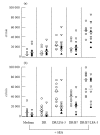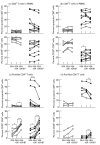Superantigen activation of CD4+ and CD8+T cells from HIV-infected subjects: role of costimulatory molecules and antigen-presenting cells (APC)
- PMID: 9472656
- PMCID: PMC1904857
- DOI: 10.1046/j.1365-2249.1998.00465.x
Superantigen activation of CD4+ and CD8+T cells from HIV-infected subjects: role of costimulatory molecules and antigen-presenting cells (APC)
Abstract
T cell receptor (TCR) triggering via superantigens induces decreased proliferative responses and increased apoptosis in T cells from HIV-infected patients compared with controls. Our aim was to delineate the role of intrinsic T cell defects, of APC dysfunction and of cytokines and costimulatory signal dysregulation in the deficient responses of CD4+ and CD8+ T cells from HIV+ subjects to the superantigen Staphylococcus enterotoxin A (SEA). Proliferation and IL-2R alpha up-regulation on SEA-stimulated CD4+ and CD8+ T cells in whole blood were reduced in HIV+ subjects with CD4 counts < 500, compared with controls. Neither addition of IL-2, IL-12 or phorbol myristate acetate (PMA) nor neutralization of endogenous IL-10, tumour necrosis factor-alpha (TNF-alpha), TNF-beta or transforming growth factor-beta (TGF-beta) could restore the decreased activation by SEA. Possible intrinsic T cell defects were studied by presenting SEA on HLA-DR-transfected Chinese hamster ovary (CHO) cells, co-expressing LFA3 and/or CD80, to purified T cells. In this system CD8+ T cells from most HIV+ patients were hyporesponsive with regard to IL-2 production, IL-2R alpha up-regulation and proliferation, whereas clearly reduced responses were only shown in CD4+ T cells from AIDS patients. Similarly, apoptosis was increased in CD8+ T cells from all patients, but only in CD4+ T cells from AIDS patients. During HIV infection, the responses to TCR triggering through SEA are deficient in both T cell subsets. The intrinsic defect appears earlier during disease progression in purified CD8+ T than in CD4+ T cells, it occurs in conjunction with both CD2 and CD28 costimulation, and it is correlated with increased levels of apoptosis.
Figures

 , n = 20) and group 3, CD4 counts < 200 (
, n = 20) and group 3, CD4 counts < 200 ( , n = 17). Median ± confidence interval (CI) are given. Significant differences between patients and controls are indicated: *P < 0.05; **P < 0.01; ***P < 0.002; ****P < 0.0005. NS, Not significant.
, n = 17). Median ± confidence interval (CI) are given. Significant differences between patients and controls are indicated: *P < 0.05; **P < 0.01; ***P < 0.002; ****P < 0.0005. NS, Not significant.


Comment in
-
Immune activation in the context of HIV infection.Clin Exp Immunol. 1998 Jan;111(1):1-2. doi: 10.1046/j.1365-2249.1998.00483.x. Clin Exp Immunol. 1998. PMID: 9472654 Free PMC article. Review. No abstract available.
References
-
- Schwartz RH. Costimulation of T lymphocytes: the role of CD28, CTLA-4, and B7/BB1 in interleukin-2 production and immunotherapy. Cell. 1992;71:1065–8. - PubMed
-
- Linsley PS, Ledbetter JA. The role of the CD28 receptor during T-cell responses to antigen. Annu Rev Immunol. 1993;11:191–212. - PubMed
-
- Janeway CAJ, Golstein P. Lymphocyte activation and effector functions. Editorial overview. The role of cell surface molecules. Curr Opin Immunol. 1993;5:313–23. - PubMed
-
- Bierer BES, Herrmann S, Burakoff SJ. Interaction of CD2 with its ligand, lymphocyte function-associated antigen-3, in human T cell proliferation. J Immunol. 1988;140:3358–63. - PubMed
Publication types
MeSH terms
Substances
LinkOut - more resources
Full Text Sources
Other Literature Sources
Medical
Research Materials

